A Museum Needs to Be an Exceptionally Good Dancer
Interview with Cecilia Widenheim, chief curator of the Swedish and Nordic art collection, and Ann-Sofi Noring, co-director of the Moderna Museet in Stockholm and Malmö
Zofia Chojnacka: Moderna Museet has one of the world's finest collections of 20th and 21st century art. The Swedish and Nordic section of the collection of sculptures, paintings, and installations now comprises some 3,700 works, of which some 350 are from neighbouring Nordic countries. What can we learn about the international section of the collection?
Cecilia Widenheim: Briefly, you could say that the international section of the Moderna Museet collection has 3-4 main cores: together with the Philadelphia Museum of Art, the world's largest collection of works by Marcel Duchamp, the American pop collection that was built up during the Pontus Hulténs directorship in Stockholm 1958-73 (who later directed Centre Pompidou, and Palazzo Grassi, among other places) and the Russian avant-garde, with seminal pieces by Malevich, Tatlin, Rodchenko and Alexandra Ekster. The unique collection of international photography is being researched right now through a series of catalogues raisonnés published by Steidl Verlag in Göttingen.
- The Change of Scenes exhibition presents over 100 works from the collection, viewed from the perspective of the 1920s - les années folles, characterized by the search for alternative modern "spaces" that took European artists to North Africa and Asia. What were the criteria for the works' selection?
C.W.: The selection builds on the attraction between visual art and performative arts in the early 20th century. When I researched the character of the productions by the Swedish Ballet, I realized that strong influences from art of the Middle East, North Africa, and the Orient within Modernism were very present in [the Ballet's] collaborative work for the stage in Paris, but also in some of the museum's key works from the period. In the exhibition, we see examples such as Moroccan Landscape by Henri Matisse from 1912, Kairuan. Before the Gate painted by Paul Klee in Tunisia in 1914, but also early cubist works by Picasso echoing the impact from African sculpture, just to mention a few. A special section is devoted to the Swedish painter, editor, and translator Ivan Aguéli who spent many years in Cairo, converted to Islam and edited the journal Il Convento that aimed to discuss "orientalism" as a phenomenon, and create a dialogue between Western culture and the Muslim world. Of course, this is a story heavily marked by colonial perspectives. The core of the exhibition is the art collection of Rolf de Maré, who collected avant-garde already in the 1910s - Picasso, Braque, Léger and Brancusi - a fantastic body of works that he donated to Moderna Museet at the end of his life.

Nils Dardel, Jean Börlin in Siamese Dance, 1919, © Nils von Dardel/BUS 2011
- The key figure of the presentation is Rolf de Maré, a Swedish collector, theatre producer, founder and director of a controversial dance company. The première of Ballets Suèdois (Swedish Ballets) on 25 October 1920 with ambitious choreography by Jean Börlin, took place at the splendid Théâtre des Champs-Élysées, the best equipped stage in Paris, a meeting ground of the international elite with "English comfort, German technology, French taste" (as advertisements promised). In the theatre's marble façade, a high relief by Antoine Bourdelle called The Dance, one can recognize Vaslav Nijinski and Isadora Duncan. Everyone who was anyone in Paris, including Serge Diaghilev, attended the première. Did Ballets Russes (The Russian Ballets) face a rival that challenged its monopoly of avant-garde ballet - the Ballets Suèdois?
C.W.: The relation between Ballets Russes and Ballets Suédois is a chapter that is not touched upon in the exhibition. However, the productions of the Russian ballets were certainly very important in the whole cultural sphere of the 1910s and 1920s of Paris and Europe. It was a huge success in many perspectives and their work became seminal both for art, fashion and performance - but the way they collaborated with artists for stage and costume design and their commissioning of new music by composers like Stravinsky was a big source of inspiration for Rolf de Maré and the Swedish Ballet who also started a bit later, in 1920. The first ideas to create a contemporary ballet were actually discussed with Mikhail Fokin, the Russian choreographer who worked at the Stockholm Opera some years. He was never part of realizing the project, though. It is important to understand the role of a city like Paris in those years; it served as a melting pot for avant-garde and interdisciplinary culture and transnational exchange, but also for queerness and gender bending. Today's research into the cultural life and moralism of the time has shown that Rolf de Maré, openly gay with an aristocratic background, would never have been able to start a project like Ballet Suédois in Sweden, it was all too controversial.
- The new dance that flourished in the opera houses and the concert halls of Europe up to the 1930s is identified not only by its choreography but also by the style of its scenography. Beginning with Loie Fuller, with her extraordinary use of light (as seen in a Lumière brothers film) - regardless the subject, the music, even the choreography, a ballet was as modern as it looked. The dancers of the Ballets Suèdois wore modernist costumes from the ateliers of Marie Muelle and Max Weldy, leading Paris costume houses. The most extreme and frenzied experiments of Ballets Suèdois seem to culminate in aesthetics of Fernand Léger, for whom star performers had to accept the role of moving scenery. Can we say the sign was in the design - in the way the body was clothed (or unclothed), in a way the stage was arranged?
C.W.: I think the immediate success that the Swedish Ballet experienced in Paris is the result of some contributing factors, some good luck, and a stroke of genius. The list of collaborating artists, directors, and composers is simply amazing, and contains many of the most interesting people in Paris around 1920. Another key is probably the intelligent programming of Rolf de Maré, the company combined ultramodern cubo-futurist ballets in design by Fernand Léger with productions with a trendy exotic and orientalist touch, like Dervish Dance and Midsummer Night's wake, a ballet showing "pagan" rituals from the North. But first and foremost, the productions were based on an authentic belief that contemporary ballet was an art form in itself, not merely entertainment, and that the new modern urban life was worth new stories, new expressions and new movements and sounds. Many of the ballets also contained improvised parts, which is radical in itself.
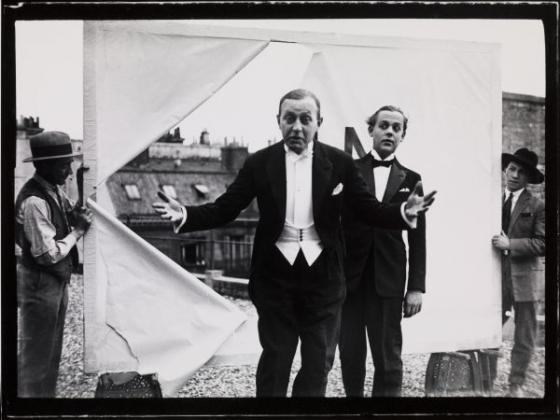
Photograph from the shooting of Entr’acte with Rolf de Maré and Jean Börlin, 1924 © Dansmuseet, Stockholm
- The goal of Rolf de Maré's new ballet was Gesamtkustwerk, a synthesis of the arts, a total work of art, a fully collaborative medium, where the artists met as equals and where performance served the multiple functions of art gallery, concert hall, and theatrical showcase for the Paris avant-garde - for the composers (members of the group championed by Eric Satie and Jean Cocteau, known as Les Six), as well as for many modern painters. "Modern ballet is the synthetic fusion of four fundamentally divergent arts: choreography, painting, music, and literature. The Swedish Ballet has always held as its principle the intimate association of these four elements and which mutually supplement one another and offer the possible approach to a perfect totality,"* writes Rolf de Maré in 1926 in Little Review, a pioneering American literary magazine that published modernist writers, Dadaist poetry and artwork, including Ulysses by James Joyce. Rolf de Maré was also the first to make film a part of the ballet text; premièred in 1924, Relâche (with a scenario by Francis Picabia, who also designed remarkable sets) included a cinematic interlude Entr'acte by René Clair, that has since become a film classic - it has no story, its images are liberated from the obligation to convey meaning. What was de Maré's input into this film?
C.W.: Obviously, without de Maré there would have been no film, he financed the project of course, but more important is the way he trusted young and upcoming artists and gave both support and carte blanche. This was one of René Clair's first films. He also risked the credibility of the whole theater and ballet company, as he exposed the audience to quite a bold contemporary performance signed Picabia et al. I would give my right hand to experience Rêlache live...
[See the film at: http://www.ubu.com/film/clair_entracte.html ]
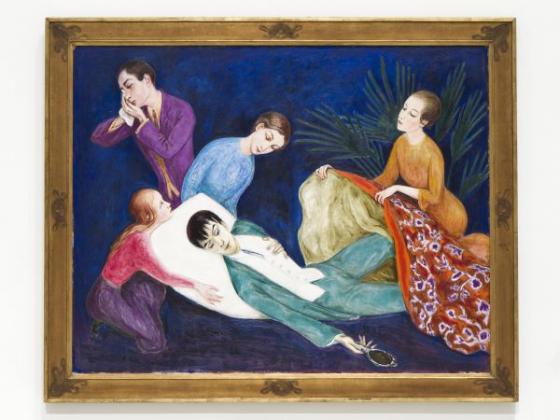
Nils Dardel, The Dying Dandy, 1918. , © Nils von Dardel/BUS 2011. Photographer: Terje Östling
- The painting Dying Dandy (Den döende dandyn) (1918) by Nils Dardel - who was influenced by the Post-Impressionists, the pure colours of the Fauvists, and Japanese woodcuts - seems to be an emblematic work of the exhibition. The Dardel masterpiece was sold in 1984 at the highest price paid (at the time) for a painting by a Swedish artist. Its charming tableau vivant version was used in a video advertisement for the exhibition Ten Stories (2007) at Moderna Museet. Den döende dandyn is also the title of a 2006 novel by Mari Jungstedt, a popular Swedish crime fiction author. In the sketch for this famous painting, Dardel grouped an all-male crowd of mourners around the dying man with a mirror in his hand ("To live and sleep before a mirror" - the dandy's slogan according to Baudelaire). In the actual painting, two women replace two of the men. Does it reflect the artist's self-destructive, itinerant and hectic life, as well as the fascination in Parisian artist circles with gender bending, androgyny and queerness?
[See the advertisement at: http://wn.com/Nils_von_Dardel ]
C.W.: The painting The Dying Dandy has been interpreted in many ways since it was painted in 1918, and very often it has been connected to the artist's own personal life in the art and gay circles of Paris in the 1910s. Dardel was a true elegant who spoke French fluently and got to know Parisian intelligentsia early on. He spent a short period at Matisse's school in Paris, but I think his travels with Rolf de Maré, with whom he had a relationship, to Japan, Tunisia, Algeria and Tenerife, were actually much more important.
The subject for the painting, a dressed up dandy who, with a mirror in his hand, says farewell to his friends (a man is found in the role as the "mourner") has often been described as the artist's farewell to his life as dandy. A year later, he met a woman, married and started a family a couple of years later.
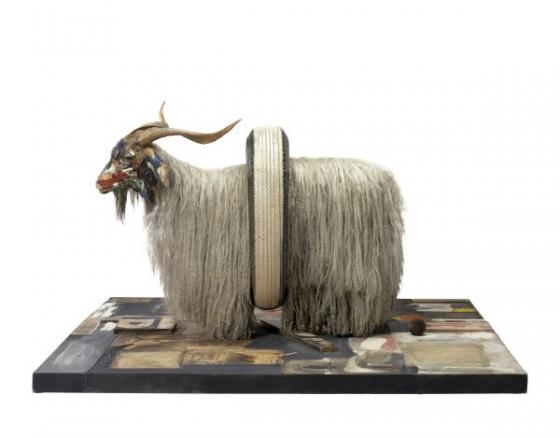
Robert Rauschenberg, Monogram, 1955-59, © Estate of Robert Rauschenberg/BUS 2011, Stockholm/VAGA, NY
- One of Moderna Museet's most famous, beloved and depicted works is Monogram (1955-1959, commonly called "The Goat") by Robert Rauschenberg, one of his "combines" (collages of found objects), which is an angora stuffed goat standing on a wood platform with a rubber tyre around its middle and paint applied liberally to its face. Robert Rauschenberg is also the artist behind Moderna Museet's current logo, which originates from his 1983 collage for the Twenty-Five Years with Moderna Museet catalogue; his "signature," rediscovered in 2004, became a veritable symbol of the museum's new identity. Does the museum share a strong relationship with American art?
An-Sofi Noring: Yes, Moderna Museet was started in 1958 when the art scene was developing very much in the USA, after the Second World War. No wonder that Pontus Hultén was interested and got to know many of the artists there - Andy Warhol had his first European show in Stockholm; Jasper Johns, Robert Rauschenberg and many others were here and made performances, exhibitions and left traces of all kinds.
- Moderna Museet's collection of photography comprises more than 100,000 photographs, ranging from 1840 to the present day. In 2011, the museum took a radical step with Another Story. 1000 Photographs from the Moderna Museet Collection. Over the year, the permanent collection exhibition space in Stockholm consisted entirely of photography and photo-based art. "This is possibly the most extreme re-hanging of the collection undertaken in the history of the museum," declared Daniel Birnbaum and Ann-Sofi Noring, the museum's new directors. It looks like a big lesson in photography and the history of the contemporary world, as photography literally means, "written in light." The history - is it a key to construction and narrative of the exhibition?
A-S. N.: The history is now. What we have done with Another Story is to show that there is not one final version, there are more than several. This is only one of the many ways to show photography. It is very radical though, and - to our knowledge - it has not been done in this extreme way before. Now, we have also published a book on this material (together with Steidl) where there are essays elaborating on the themes.
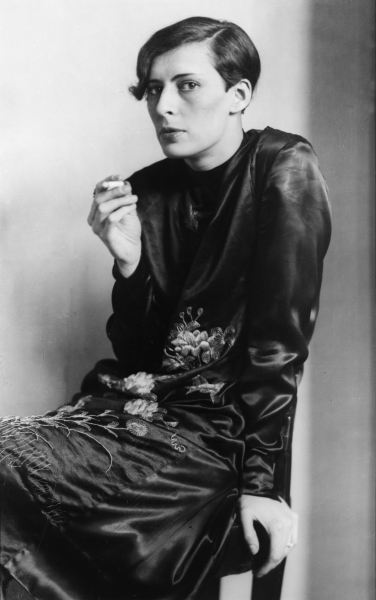
August Sander, Die elegante Frau - Sekrutärin beine WDR, 1927/ca 1975, © August Sander / BUS 2011
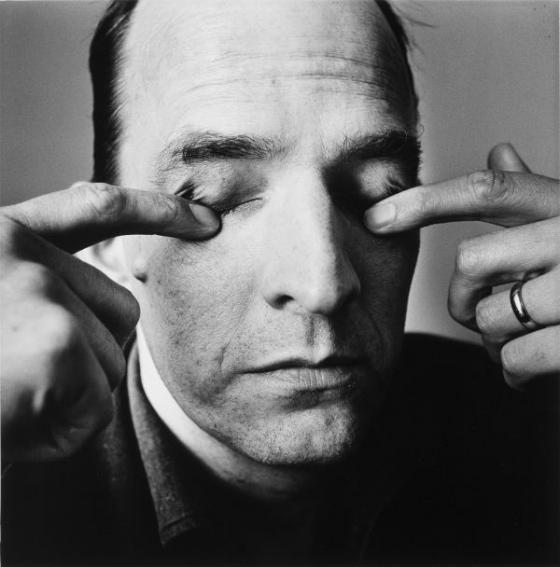
Irving Penn, Ingmar Bergman, Stockholm, 1964, © Irving Penn Foundation. No cropping or text over the image is allowed
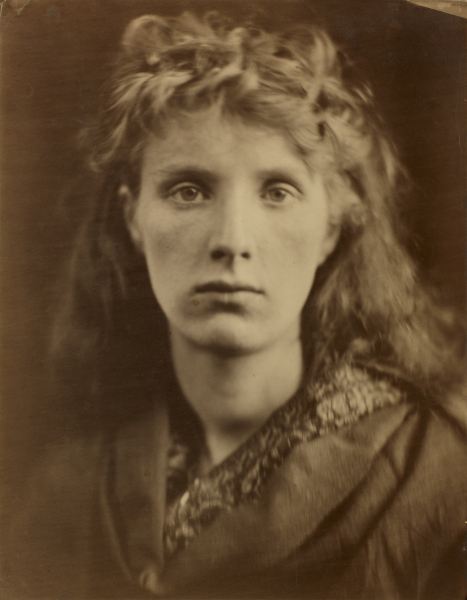
Julia Margaret Cameron, The Mountain Nymph, Sweet Liberty, 1866, © Julia Margaret Cameron

Liina Siib, Presumed Innocence II, # 2, 1997, © Liina Siib/BUS 2011
- According to Lars Nittve, Moderna Museet's former director, museums of modern arts - which serve as contemporary arenas and as collecting, historicizing institutions - should be able to establish "third spaces," creating alternative places where art, people, and ideas can roam freely. "In other words," he wrote in Artforum (summer 2010), "a museum needs to be an exceptionally good dancer in order to follow art, in whatever form it takes - materially, conceptually, socially, you name it." However, he considered the most difficult factor to define the expectations of the audience. What is the reception of the Another Story exhibition among the audience?
A-S. N.: The reception of the audience is of course, as always, multi-layered. With a couple of hundred thousand visitors a year, there are just as many answers. Striking, overwhelming, fascinating are some of the words I have caught. We try to listen to our visitors and to have a dialogue - that is part of our educational work. It is a process, going on as long as we are here.
- Change of Scenes is the planned new series of exhibitions in the Moderna Museet's branch in Malmö, which will show a larger selection of works once a year from the rich main collection of paintings, sculptures, photographs, and films in a fresh, new presentation. What we will see in the future?
C. W.: Next year's version of Change of Scenes will be devoted to Surrealism, a survey that will start in the Dada movement and combine the museums fantastic pieces by Magritte, Dali, Toyen, Meret Oppenheim among others with examples of contemporary takes on surrealism from the 1990 and 2000s up to the present. In 2013, Russian Constructivism will be the main display of the collection.
Change of Scenes. Works from the Moderna Museet Collection by Dardel, Matisse, Abdul-Hâdi, Hjertén, Léger a.o.
Moderna Museet Malmö, open until 5 February 2012
Curator: Cecilia Widenheim
Another Story. 1000 Photographs from Moderna Museet Collection
Part 1. Possessed by the Camera (1970 - 2010)
Part2. See the World! (1920-1980)
Part 3. Written in Light (1840 - 1930)
Moderna Museet Stockholm, open until 19 February 2012
Curators: Daniel Birnbaum, Ann-Sofi Noring
* Rolf de Maré, The Swedish Ballet and the Modern Aesthetics, "The Little Review", Winter 1926, New York
Interview by Zofia Chojnacka
http://www.obieg.pl/, Centre for Contemporary Art Ujazdowski Castle, Warsaw
The full Polish version of the article is available at: http://obieg.pl/felieton/23251

